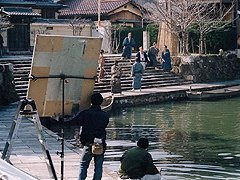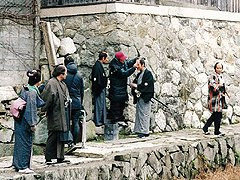Hachimanbori Moat
The Hachimanbori Moat is an artificial waterway that played a significant role in the commercial development of Omihachiman. The moat is approximately 4.7 kilometers long, and its central section is lined with white-walled storehouses and traditional wooden residences built by local merchants. For this reason, both banks of the moat are now part of the Omihachiman Important Preservation District for Groups of Traditional Buildings along with Shinmachi Street and Nagaharacho Street in the old town.
Hachimanbori dates back to 1585, when the warlord Toyotomi Hidetsugu (1568–1595) had the moat dug during the construction of Hachimanyama Castle. The waterway was part of the castle’s defense works, but it was also a canal that could be used as a transportation route between the town and Lake Biwa. The ferrying of goods via the canal and Lake Biwa to and from major cities such as Kyoto, Osaka, and Edo (now Tokyo) contributed greatly to the development and prosperity of the town. Although the castle was abandoned in 1595, the continued use of Hachimanbori as a canal helped Omihachiman maintain its status as an important trading hub, and the influence of local merchants spread throughout Japan.
Hachimanbori was regularly dredged and maintained while it was still in use, but it became dilapidated in the decades after World War II. In the 1960s, the moat became polluted with trash and other waste, and sludge accumulated on the bottom, resulting in a foul odor. In 1972, the city of Omihachiman responded to local residents’ complaints and released a plan to fill in the moat. However, citizens concerned about the loss of the town’s heritage protested, declaring “As soon as the moat is filled, we will regret it.” They launched a campaign for the moat’s preservation and began voluntary clean-up activities. As a result, the city’s plan was halted and the waterway was restored to its former beauty. Today the Hachimanbori Moat continues to be maintained by local residents. Boat rides on the moat have become a popular tourist activity, and it is frequently used as a filming location for historical movies and TV dramas.

